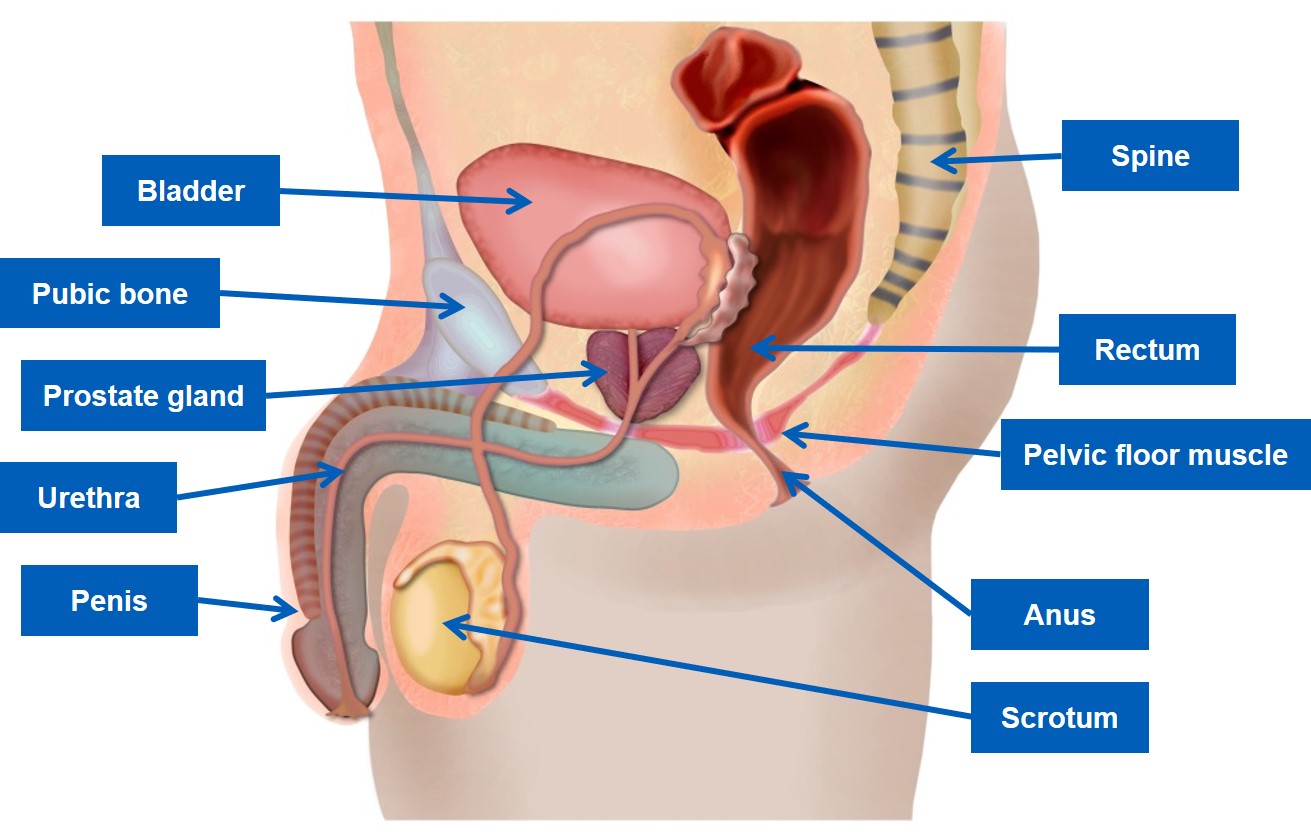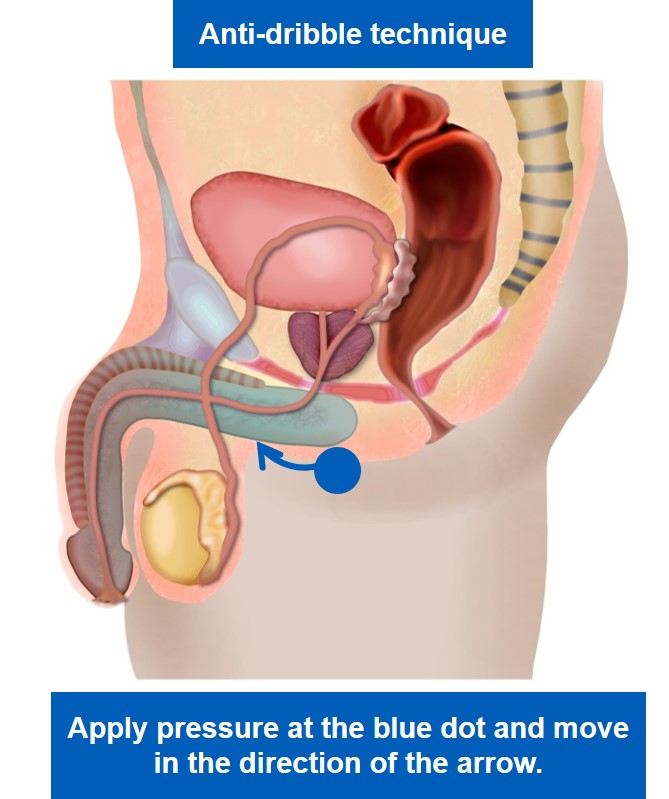Pelvic floor exercises for people with male anatomy
Last edited: 20/12/2022
What are the pelvic floor muscles?
The pelvic floor muscles:
- help to maintain urinary and bowel continence (and control wind)
- support the organs of the pelvis and maintain their position
- contribute to sexual function
- are like a hammock that runs between the pubic bone at the front and the base of the spine at the tail bone (see diagram).
Factors that can weaken these muscles include:
- age
- being overweight
- chest problems with chronic cough
- surgery (for example prostatectomy)
- heavy lifting
- standing for long periods
- constipation and/or repeated straining
- being unfit.

Why should I do pelvic floor exercises?
Any muscle that is not exercised regularly can become weakened. If the muscle becomes weakened, then coughing and sneezing can cause urinary leakage to occur. This is known as stress incontinence.
Squeezing the pelvic floor can also reduce the desire to pass water and assist in reaching the toilet in time.
How to exercise the pelvic floor muscles
Choose the place you can identify the muscles the best. It could be standing, lying, sitting on a firm chair or on the toilet.
Imagine you are about to pass wind and tighten the muscles around your anus to stop this. You should feel a tightening at the back passage, without clenching your buttocks, holding your breath or pulling your abdominal muscles in.
Try to pull through to tighten around the front passage as if you are trying to stop your urine flow.
Helpful hint: Stand in front of a mirror (undressed), the penis will move when you squeeze your pelvic floor muscles.
There are two types of exercises - both will help develop your pelvic floor muscles.
Slow twitch
Tighten the muscle and hold as long as you can, (you may be able to hold for two seconds or longer). Then relax the muscles for five seconds and repeat the same length of twitch again. Repeat this up to 10 times. This exercise helps stamina.
Fast twitch
Try to squeeze your muscle quickly and as tight as possible, like a short sharp blink. Repeat this up to 10 times. This will help make your muscles stronger and respond more quickly when needed.
Do your exercises carefully. Fewer good quality exercises are better than more half-hearted ones.
When to exercise the pelvic floor?
With practice your muscle should be able to hold longer (for 10 seconds) and do more repetitions before it is tired. Try to do this whole exercise routine at least five or six times every day at regular intervals. Think of different activities that may help you remember to exercise, such as when having a drink or in the car at red traffic lights.
Try to do your exercises in other positions such as standing, as this will improve your muscle even further.
Try not to stop the flow of urine regularly as this can “confuse” the bladder but this can be done as a test, not more than one a fortnight, to assess your progress.
Following a radical prostatectomy your consultant may ask you to stop the flow of urine, at specific times.
Remember that the exercises will not improve things over night - it will take several weeks before you notice any real improvement. The more effort you put in the more you will achieve. Exercises will become much easier to perform as the muscle gets stronger and can become a habit for life.
Don’t give up! Remember if the problem persists seek professional advice.
If you are unsure of whether you are exercising your pelvic floor muscles correctly you should contact your continence or uro-gynae healthcare professional.
Other helpful tips for a healthier bladder
Anti-dribble technique
If you leak after you have passed water, you should always stand to urinate (if possible), take your time and try tightening your pelvic floor muscles after you have finished urinating. Place a fingertip behind the scrotum, apply gentle pressure and move the finger forward towards the base of the penis under the scrotum. This empties the urine out of the u-bend. When empty, shake or squeeze as normal to remove the last drops. Before leaving the toilet repeat this exercise twice to ensure the urethra is completely empty (see diagram).

What can be done to help?
- Fluid intake – do not restrict your fluids. This will often make matters worse. Try to drink two litres a day. Try to avoid caffeine, fizzy drinks and alcohol. Reduce caffeine intake gradually to avoid headaches.
- Remember to tighten your pelvic floor muscles before undertaking an activity that causes the leakage.
- Don’t get into the habit of going to the toilet just in case. Only go when your bladder is full. Ideally you should be able to last two to three hours between wees. If you need to go more than every two hours you can retrain your bladder to wait for longer by either tightening your pelvic floor or distracting yourself from needing to go to the toilet.
- Diet – a well-balanced diet with a good fibre intake will help to keep your bowels regular.
- Avoid constipation and straining (seek advice if necessary).
- Exercise – a little exercise daily will also help.
- Clothing – if you have poor mobility or dexterity ensure sure your clothes are easy and simple to manage.
- Keep your weight within the right range for your height and age.
- A cough can weaken pelvic floor muscles – seek advice from your doctor to reduce persistent coughing (and sneezing).
Be patient! Any exercise programme takes time to work. Everyone is different.
Your physiotherapist, bladder and bowel nurse specialist or GP can help with further advice if frequent trips to the toilet and accidents are a problem.
Where can you go next?
For further help and advice contact your GP, who will refer you to the physiotherapist or your local bladder and bowel nurse specialist.
This information should only be followed on the advice of a healthcare professional.
Do you have feedback about our health services?
0800 030 4550
Text 07899 903499
Monday to Friday, 8.30am to 4.30pm
kentchft.PALS@nhs.net
kentcht.nhs.uk/PALS
Patient Advice and Liaison Service (PALS)
Kent Community Health NHS Foundation Trust
Trinity House, 110-120 Upper Pemberton
Ashford
Kent
TN25 4AZ
![]()
Donate today, and help the NHS go above and beyond. Visit kentcht.nhs.uk/icare
If you need communication support or this information in another format, please ask a member of staff or contact us using the details above.
